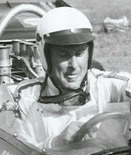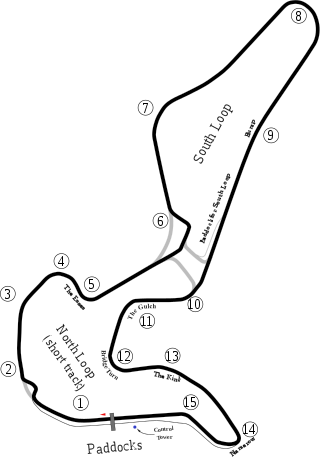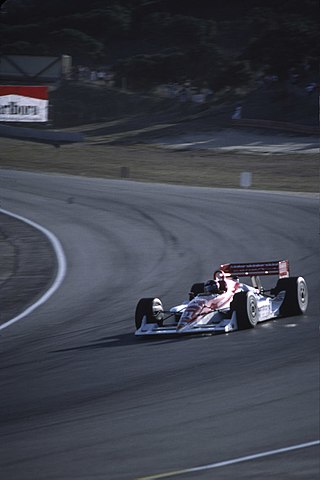
Denis Clive Hulme was a New Zealand racing driver, who competed in Formula One from 1965 to 1974. Nicknamed "The Bear", Hulme won the Formula One World Drivers' Championship in 1967 with Brabham, and won eight Grands Prix across 10 seasons.
The Surtees Racing Organisation was a race team that spent nine seasons as a constructor in Formula One, Formula 2, and Formula 5000.

Alfred Unser Jr. – nicknamed "Little Al" to distinguish him from his father, Al Unser – is an American retired racing driver. Known primarily for his Championship car career, Unser won two CART championships, and is a two-time winner of the Indianapolis 500.

Graham Peter McRae was a racing driver from New Zealand.
Connew Racing Team, commonly known as Connew, was a short lived British Formula One constructor. Founded in 1971 by Peter Connew, the team constructed a single car, the PC1. The first monococque had to be aborted due to a change in regulations and the second tub was known as PC2. However, record books show the car driven by Migault and others as PC1. The intent was to compete in the Formula One World Championship in 1972, but a lack of financial and technical resources meant that the car only managed to start in one championship race, the 1972 Austrian Grand Prix, with French driver François Migault at the wheel. Following the Austrian race, the car competed in a handful of non-championship races before being converted to meet Formula 5000 specifications for the 1973 season. The chassis was damaged beyond repair during the season finale at Brands Hatch and the team closed.
Fittipaldi Automotive, sometimes called Copersucar after its first major sponsor, was a Formula One racing team and constructor that competed from 1975 to 1982. It was the only Formula One team to have been based in Brazil. The team was formed during 1974 by racing driver Wilson Fittipaldi and his younger brother, double world champion Emerson, with money from the Brazilian sugar and alcohol cooperative Copersucar. The team raced under a Brazilian licence. Emerson Fittipaldi became a driver for the team in 1976 after leaving McLaren, but was unable to replicate his earlier success with the family-owned team. Future world champion Keke Rosberg took his first podium finish in Formula One with the team.

Circuit Mont-Tremblant is a 4.218 km (2.621 mi) race circuit located approximately 130 km (81 mi) north of Montreal, Quebec, in the city of Mont-Tremblant, Canada. It is the second-oldest existing race track in Canada, and was originally known as Circuit Mont-Tremblant-St-Jovite until it was renamed in the 1970s. Set in the shadow of the Mont-Tremblant ski hill, the twisting fifteen-corner track uses the natural topography and elevation of the land.

Formula 5000 was an open wheel, single seater auto-racing formula that ran in different series in various regions around the world from 1968 to 1982. It was originally intended as a low-cost series aimed at open-wheel racing cars that no longer fit into any particular formula. The '5000' denomination comes from the maximum 5.0 litre engine capacity allowed in the cars, although many cars ran with smaller engines. Manufacturers included McLaren, Eagle, March, Lola, Lotus, Elfin, Matich and Chevron.

Didier Maurice Theys is a Belgian sports car driver. He is a two-time overall winner of the 24 Hours of Daytona ; a winner of the 12 Hours of Sebring (1998); the Sports Racing Prototype driver champion of the Grand-American Road Racing Association (2002) and the winner of the 24 Hours of Spa. He was also the polesitter (1996) and a podium finisher at the 24 Hours of Le Mans. The podium finish in 1999 was a third overall in the factory Audi R8R with co-drivers Emanuele Pirro and Frank Biela. Theys' first appearance at Le Mans was in 1982, while his last start in the world's most famous endurance sports car race came 20 years later in 2002.

John Fitzpatrick is a British former racing driver, winning many titles throughout his career. He works within motorsport as a consultant doing corporate events and driver management. He published a book "Fitz-My Life at the Wheel" in 2016.
The 1979 Can-Am season was the twelfth running of the Sports Car Club of America's prototype-based series and the third running of the revived series. Formula One legend Jacky Ickx was declared champion, winning five of the ten rounds and finishing second at Road Atlanta. Chevrolet again dominated the season. The top chassis builders were Lola, Prophet, and Spyder, with Vern Schuppan finishing third at Watkins Glen in an Elfin and Al Holbert finishing third at Road America in a Hogan.
The 1982 Can Am Series season was the fifteenth running of the Sports Car Club of America's prototype series, and the sixth running of the revived series. 1982 brought new competition for Chevrolet in the form of Hart and Cosworth. Hart would podium in three races while Cosworth would podium in two. The most dominant chassis were Frissbee, Marguey, March, VDS-001, and Ensign. Al Unser Jr. would win at Road Atlanta, Laguna Seca, and Mosport twice, with a podium at Mid Ohio, at Riverside, and at Caesar's Palacae. Unser would be declared champion.
The 1983 Can Am season was the sixteenth running of the Sports Car Club of America's prototype series and the seventh of the revived series. 1983 marked the second year of Chevrolet having major competition, with Cosworth taking second at Mosport, first at Lime Rock, second at Trois-Rivières, first at the second race at Mosport, and second at Sears Point. Hart would take third at Lime Rock and third at Trois-Rivières. Porsche would get its first podiums this season, with a win at Road America and third at the second race at Mosport. The dominant chassis were Frissbee, Ensign, Lola, VDS, Scandia, and Ralt. Jacques Villeneuve, Sr. was declared champion, with podiums in almost every race. He would, however, become the final major racecar driver to win a Can Am championship.
The 1984 Can Am season was the seventeenth running of the Sports Car Club of America's prototype series, and the eighth running of the revived series. 1984 would mark a major downturn in the series, as Juan Manuel Fangio II would become the last major driver to podium in a Can Am Series race, finishing third at Dallas. The dominant manufacturers were Chevrolet, Hart, BMW for the first time with a third-place finish at Brainerd, Cosworth, Lola, Ralt, and March. Dominant chassis were VDS, March, Frissbee-Lola, Ralt, and Williams with their first podium with a third-place finish at Lime Rock. Michael Roe was declared champion, with seven wins. The final race at Green Valley would feature the final truly notable driver in series history, John Andretti.
The 1981 Australian Drivers' Championship was a CAMS sanctioned Australian motor racing title open to racing cars complying with Australian Formula 1. It was the 25th Australian Drivers' Championship. The title winner, Alfredo Costanzo was awarded the 1981 CAMS "Gold Star".
The March 817 was a British sports prototype racing car, built by March Engineering in 1981 for the Can-Am series. As with all other full-size Can-Am cars of the time, it used a mid-mounted 5-litre, naturally-aspirated Chevrolet V8 engine. Two cars are known to have been built. Paul Newman Racing won the Team's championship of the Can-Am series in 1981 with the March 817, whilst their main driver, Teo Fabi took second in the driver's standings.
The 1987 Can-Am Teams season was the twentieth and final running of the Sports Car Club of America's Can Am Series and the eleventh and final running of the revived series. For 1987, the series added March 85Cs from CART, although some continued to use the old prototypes. Bill Tempero was declared champion. The Marches acted as a "single seat Can Am" group, replacing the old Formula 5000 cars.
Ken Duclos is a Americas former racing driver. Duclos competed in the Trans-Am Series, Atlantic Championship among other series.
Gerald Jon 'Jerry' Hansen is a former racing driver. Hansen has won a record of 27 SCCA National Championships. Hansen has also competed in Can-Am, the Atlantic Championship, USAC ChampCar among other series.
The 1982 National Panasonic Series was an Australian motor racing contest for Australian Formula 1 cars. It was the second running of the National Panasonic Series.






